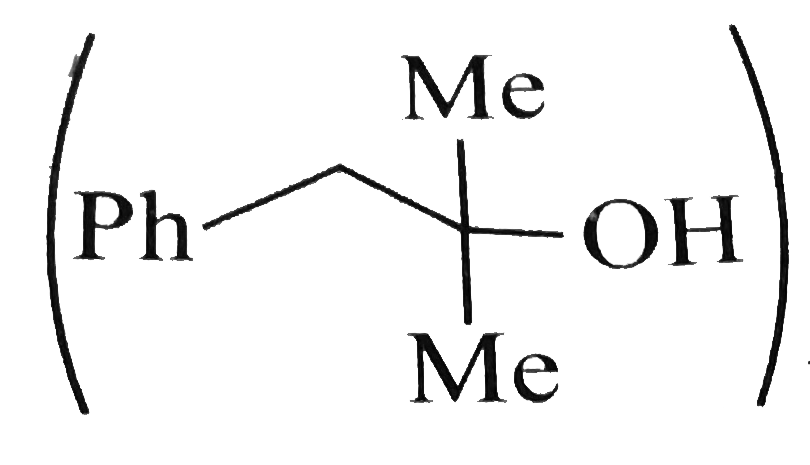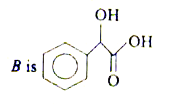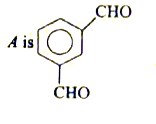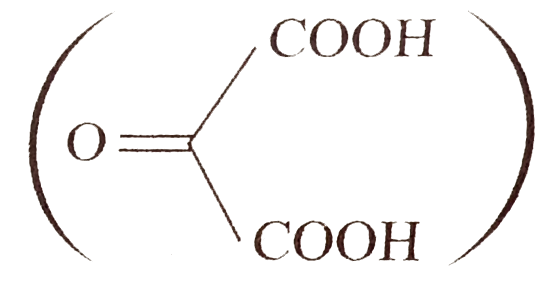An alkance (A) on chlorination at gives a mixtrue of four different monochlorinated derivatives , and . Two of these derivatives give the same stable alkene on dehydrohalogenation. On oxidation with hot alkaline followed by acidification, gives two products . Give the structrues of with proper reasoning.
To solve the problem step by step, we will identify the structures of the compounds A to H based on the information provided.
Step 1: Identify the alkane (A)
The alkane with the formula C5H12 is pentane. The structure of pentane can be represented as follows:
Structure of A (Pentane):
A: CH3−CH2−CH2−CH2−CH3
Step 2: Chlorination of A
When pentane undergoes chlorination, it can form four different monochlorinated derivatives. The chlorination can occur at different positions on the carbon chain.
Structures of B, C, D, and E:
1. B: Chlorination at the first carbon:
B: CH2Cl−CH2−CH2−CH2−CH3
2. C: Chlorination at the second carbon:
C: CH3−CHCl−CH2−CH2−CH3
3. D: Chlorination at the third carbon:
D: CH3−CH2−CHCl−CH2−CH3
4. E: Chlorination at the fourth carbon:
E: CH3−CH2−CH2−CH2Cl
Step 3: Dehydrohalogenation to form (F)
Next, we perform dehydrohalogenation on the monochlorinated derivatives to form alkenes. We need to find which two derivatives yield the same alkene (F).
1. From B: Removing HCl gives:
F: CH2=CH−CH2−CH3
2. From C: Removing HCl gives:
F: CH3−CH=CH−CH3
3. From D: Removing HCl gives:
F: CH3−CH=CH−CH2−CH3
4. From E: Removing HCl gives:
F: CH3−CH2−CH=CH2
The derivatives C and D yield the same alkene:
F: CH3−CH=CH−CH3(2-butene)
Step 4: Oxidation of (F) to form (G) and (H)
When F (2-butene) is oxidized with hot alkaline KMnO4 followed by acidification, it forms two products:
1. G: Oxidation leads to the formation of:
G: CH3−CO−CH3(acetone)
2. H: Oxidation also leads to the formation of:
H: CH3−COOH(acetic acid)
Summary of Structures
- A: Pentane CH3−CH2−CH2−CH2−CH3
- B: Monochloropentane at C1
- C: Monochloropentane at C2
- D: Monochloropentane at C3
- E: Monochloropentane at C4
- F: 2-butene CH3−CH=CH−CH3
- G: Acetone CH3−CO−CH3
- H: Acetic Acid CH3−COOH
The alkane with the formula C5H12 is pentane. The structure of pentane can be represented as follows:
A: CH3−CH2−CH2−CH2−CH3
When pentane undergoes chlorination, it can form four different monochlorinated derivatives. The chlorination can occur at different positions on the carbon chain.
1. B: Chlorination at the first carbon:
B: CH2Cl−CH2−CH2−CH2−CH3
2. C: Chlorination at the second carbon:
C: CH3−CHCl−CH2−CH2−CH3
3. D: Chlorination at the third carbon:
D: CH3−CH2−CHCl−CH2−CH3
4. E: Chlorination at the fourth carbon:
E: CH3−CH2−CH2−CH2Cl
Next, we perform dehydrohalogenation on the monochlorinated derivatives to form alkenes. We need to find which two derivatives yield the same alkene (F).
F: CH2=CH−CH2−CH3
2. From C: Removing HCl gives:
F: CH3−CH=CH−CH3
3. From D: Removing HCl gives:
F: CH3−CH=CH−CH2−CH3
4. From E: Removing HCl gives:
F: CH3−CH2−CH=CH2
F: CH3−CH=CH−CH3(2-butene)
When F (2-butene) is oxidized with hot alkaline KMnO4 followed by acidification, it forms two products:
G: CH3−CO−CH3(acetone)
2. H: Oxidation also leads to the formation of:
H: CH3−COOH(acetic acid)
- A: Pentane CH3−CH2−CH2−CH2−CH3
- B: Monochloropentane at C1
- C: Monochloropentane at C2
- D: Monochloropentane at C3
- E: Monochloropentane at C4
- F: 2-butene CH3−CH=CH−CH3
- G: Acetone CH3−CO−CH3
- H: Acetic Acid CH3−COOH
Topper's Solved these Questions
- ISOMERISMBOOK - CENGAGE CHEMISTRY ENGLISHCHAPTER - ISOMERISMEXERCISE - (Linked Comprehension Type)Exercise
13 Videos
- ISOMERISMBOOK - CENGAGE CHEMISTRY ENGLISHCHAPTER - ISOMERISMEXERCISE - Multiple choice questions (Exercise)
38 Videos
- ISOMERISMBOOK - CENGAGE CHEMISTRY ENGLISHCHAPTER - ISOMERISMEXERCISE - Example
15 Videos
- IONIC EQUILIBRIUMBOOK - CENGAGE CHEMISTRY ENGLISHCHAPTER - IONIC EQUILIBRIUMEXERCISE - Archives Subjective
28 Videos
- NCERT BASED EXERCISEBOOK - CENGAGE CHEMISTRY ENGLISHCHAPTER - NCERT BASED EXERCISEEXERCISE - Chemical Equilibrium
73 Videos
Similar Questions
An organic compound (A) of molecular formula C5H8 when treated with Na in liquid ammonia followed by reaction with -Propyl iodide yeidls (B) C8H12 (A) gives a ketone C5H10O (e) when treated with dil H2SO4 and HgSO4 (B) on oxidation with alkaline KMnO4 gives two isomeric acids (D) and (E) C4H8O2. Give structures of compounds (A) to (E) with proper reasoning .
View SolutionTwo different G.R.(A) and (B) give the product (X)
 on reaction with (C) and (D) respectively. Give the structures of (A),(B),(C) and (D).
on reaction with (C) and (D) respectively. Give the structures of (A),(B),(C) and (D).
View Solution
Knowledge Check
An alkane C6H14 gives two monochloro derivatives on chlorination. Its possible structure is
ACH3CH2CH2CH2CH2CH3BCH3−C∣CH3H−CH2CH2CH3CCH3−C∣CH2CH3H−CH2CH3DCH3−CH3∣CH−CH3∣CH−CH3Compound (A) C8H6O2 on treatment with aq. NaOH followed by acidification gives (B) C3H2O3 which on oxidation gives benzoic acid only:
A B
B C
C D
D
Two isomeric compounds, (A) and (B), have the same formula, C11H13OCI. Both are unsaturated, yield the same compound (C) on catalytic hydrogenation, and produce 4-chloro-3-ethoxybenzoic acid on vigorous oxidation. (A) exists in geometrical isomers, (D) and (E), but not (B). Give structures of (A) to (E) with proper reasoning.
View SolutionAn aromatic compound (A), C7H5NO2CI2 on reduction with Sn/HCI gives (G), which on reaction with NaNO2/HCI gives (B). Compound (B) does not form a dye with β-naphthol. However, (B) gives red colour with ceric ammonium nitrate and on oxidation gives an acid (D) of equivalent weight 191. Decarboxylation of (D) gives (E), which forms a mono nitro derivative (F) on nitrotion. Give the structures of (A) to (F) with proper reasoning.
View SolutionAn organic compound A(C4H6CI) on reation withNa/diethyl ether gives a hydrocarbon which on monochlorination gives only one chloro derivative A is .
View SolutionCompound (A)(C12H16) on oxidation with acidic KMnO4 solution gives acetone and
 . Identify compound (A).
. Identify compound (A).
View SolutionThere are five isomeric alkenes (A, B, C, D, and E) that require 1 mol of H2 per mole of alkene for hydrogenation and give the same product (F) on hydrogenation. F is an alkane having the lowest molecular mass and is opticalar mass and is optically active. Write the structures of the compounds from A to F.
View SolutionAn acidic compound (A)(C4H8O3) loses its optical activity on strong heating yielding (B)(C4H6O2) which reacts readly with KMnO4. (B) forms a dervative (C) with SOCl2 which on reaction with (CH3)2NH gives (D). The compound (A) on oxidation with dilute chromic acid gives an unstable compound (E) which decarboxylates readily to give (F)(C3H6O). The compound (F) gives a hydrocarbon (G) on treatment with amalgamated Zn and HCl. Give the structures of (A) to (G) with proper reasoning.
View Solution
